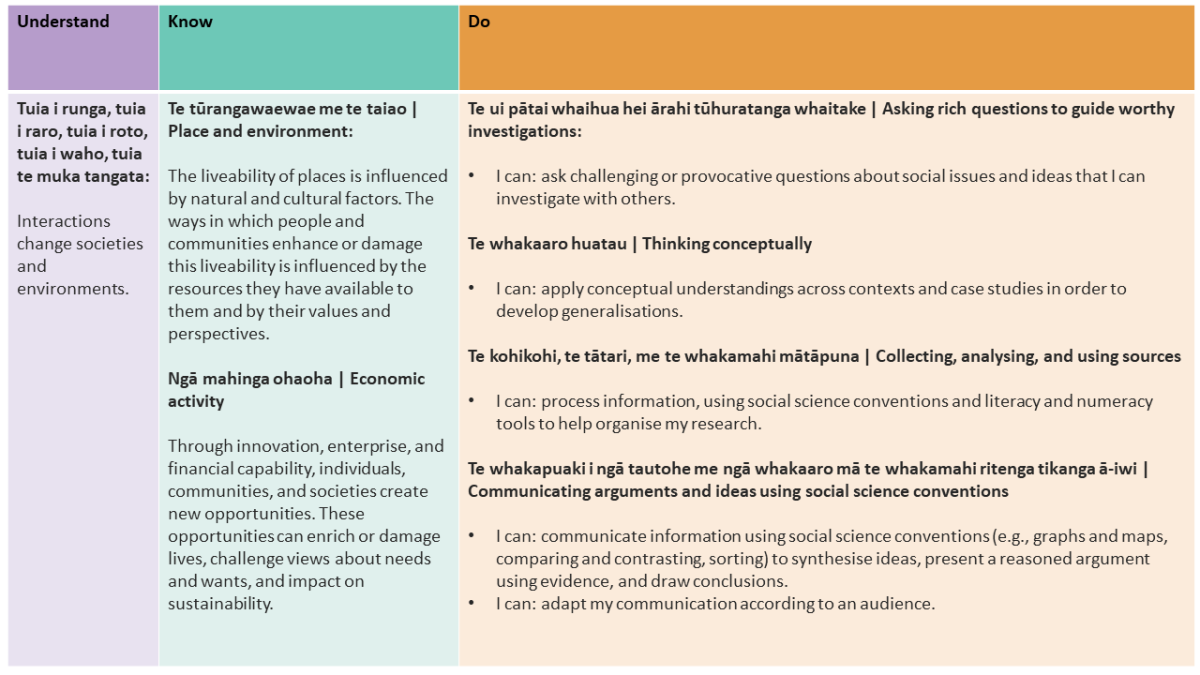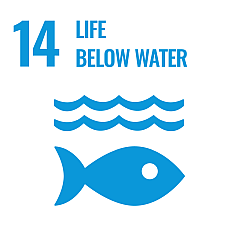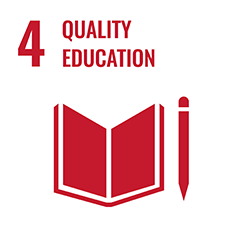<- What lies beneath? homepage
Curriculum highlights
This virtual field trip aligns with Te Mātaiaho, the refreshed New Zealand Curriculum. It integrates key learning areas in science, technology, and social science by offering a rich educational experience about seabed mapping (hydrographic surveying).
Ākonga will see how hydrographic surveys improve navigation, marine management and our understanding of what lies beneath the surface of the water. Communities, businesses, local and central governments can use this data for flood modelling, aquaculture development, and preserving cultural heritage.
Curriculum flexibility
Our field trips are cross-curricular learning experiences which can be adapted to different learning areas and progressions. You can develop your teaching approach to suit ākonga interests and needs.
Te ao Tūroa | Science
This field trip is designed for students in years 7-10, especially at level 4 of the Science learning area including level 4:
Nature of Science (Understanding Science)
Ākonga can gain insights into collaborative scientific work, observe how scientists employ technology for data collection and analysis to solve real-world problems. This helps ākonga understand how scientists collaborate and use evidence to support their ideas and conclusions.
Physical World (Physical Inquiry and Physics Concepts)
Ākonga will explore the practical application of physics concepts and laws. For instance, they can examine how echo sounders and mobile laser scanning measure depth so that the seafloor can be mapped.
Hangarau | Technology
This field trip is suitable teaching for level 4 of the Technology learning area including level 4.
Nature of Technology
Students will:
Characteristics of technology
Understand how technological development expands human possibilities and how technology draws on knowledge from a wide range of disciplines.
Characteristics of technological outcomes
Understand that technological outcomes can be interpreted in terms of how they might be used and by whom, and that each has a proper function as well as possible alternative functions.
Te ao tangata | Social sciences
Mapping the seabed allows government agencies to make informed decisions about marine resource management, supports iwi in preserving cultural heritage and livelihoods, and benefits the broader community involved in marine activities by enhancing navigation, safety and environmental sustainability. Encourage ākonga to explore the social dimensions of hydrographic surveying.
Example: This virtual field trip can effectively support progress outcomes in Phase 4 (Years 9-10) of Te ao tangata | social sciences defined by the Understand, Know, and Do (UDK) framework.

NELP Priorities
This field trip aligns with National Education Learning Priorities (NELP) by connecting ākonga with industry experts, highlighting the future of learning and work and encouraging ākonga-led learning.
Sustainable Development Goals (SDGs) UNESCO Educator Resources
The UNESCO Resources for Educators - Life Below Water (Goal 14) offers a range of educational materials and tools designed to enhance ocean awareness and sustainable resource exploitation.
The UNESCO Resources for Educators - Quality education (Goal 4) offers a range of educational materials and tools supporting skills development, highlighting opportunities for technical and vocational training, and promoting sustainability.
Reflective teacher questions
Use the following reflective questions to guide your teaching practice:
How can I help my ākonga connect the topic of mapping our seafloor to scientific and social ideas?
To address this question you can:
- Explore real-world examples and practical applications of seabed mapping in the field trip, considering its impact on various sectors and communities.
- Encourage discussions and group activities that highlight the interdisciplinary nature of this field.
Why is it important to consider the broader impacts of understanding more about our seafloor?
To address this question you can:
- Discuss how seabed mapping contributes to marine conservation, resource management, and disaster preparedness.
- Explore the economic, environmental, and cultural consequences of informed decision-making based on hydrographic data.
- Connect this understanding to Sustainable Development Goal 14, "Life Below Water," and its global significance.
How can I raise awareness among my ākonga about learning opportunities and career pathways related to mapping our seafloor, motivating them to consider future possibilities in this field?
To address this question you can:
- Invite relevant professionals or experts to share their experiences and career paths with ākonga.
- Share information about educational opportunities related to seabed mapping.
- Incorporate hands-on activities or projects that allow students to explore the practical applications of seabed mapping.
- Showcase the potential for making a positive impact on society and the environment through careers related to seabed mapping
A suggested teaching and learning framework
This approach aligns with the Understand, Know, Do (UKD) framework of Te Mātaiaho, supports learning progressions in social sciences, and reflects current science and technology learning objectives by promoting critical thinking, independent inquiry, and collaborative investigation.
Introduce and explore -> Extend learning -> Evaluate -> Enable ākonga-led inquiry -> Present and share -> Reflect
1. Introduce and explore
Start by introducing the field trip objective, highlighting the value of mapping our seafloor.
![]() Evaluate prior learning
Evaluate prior learning
Use the pre-trip survey (downloadable Word document) to assess ākonga thoughts and understanding related to seabed mapping and ignite their interest in the trip. You can incorporate this survey into interactive platforms like Kahoot!, Google Forms, or Quizlet.
Dive into the field trip resources, such as videos, images, and GIS maps, to discover the importance and techniques involved in seabed mapping. Ākonga can use the Videos - Play & think (downloadable PDF) to take notes and support group discussions and learning.
2. Extend learning
Engage ākonga in activities designed to spark discussions and foster an understanding of concepts highlighted in the field trip, with a focus on the important role of mapping our seafloor. Employ the Field trip activities to reinforce this approach.
![]() Evaluate ākonga learning
Evaluate ākonga learning
Assess readiness and stimulate thinking about the importance of understanding our seafloor and encourage ākonga-led inquiry.
- Use the post-trip survey (downloadable Word document) to measure the depth and progress of ākonga learning concerning the importance of mapping our seafloor.
- Use this Solo taxonomy rubric (downloadable Word document) to assess ākonga understanding of the role of seabed mapping.
3. Enable ākonga-led inquiry
Empower ākonga to take the lead in independent or collaborative inquiries with a specific focus on mapping our seabed, the people doing this mahi, or the techniques they use. Encourage them to generate open-ended questions and challenges related to this field.
For example:
- Environmental impact: How does mapping our seafloor contribute to maintaining the health and safety of our marine environment?
- Technological advancements: What are the technological innovations that assist in mapping our seabed?
- Social impact: How do hydrographic surveys help people, groups, communities and iwi? What positive changes can it bring to our lives?
- Career opportunities: What exciting career opportunities are available in relation to mapping the seabed and how can you get there?
Encourage ākonga to explore topics, seek information, connect with experts, and gather data for inquiries related to mapping the seabed, its applications, and exciting prospects in this field.
4. Present and share
Support ākonga to present and share their learning. This could include, but is not limited to, digital storytelling, websites, podcasts, exhibitions, video, community engagement.
![]() Evaluate ākonga learning
Evaluate ākonga learning
Assess ākonga-led inquiry and critical thinking using this Solo taxonomy rubric (downloadable Word document) as a guiding tool.
5. Reflect
After completing their inquiries and sharing their findings, encourage ākonga to reflect on what they've discovered about mapping the seabed. How has their understanding developed? What does this mean for them?
Links
- Toitū Te Whenua Land Information New Zealand
A website providing information and services related to land and property in New Zealand. - LINZ data system: New Zealand marine charts
Marine charts of New Zealand for commercial shipping and recreational boating. - Discovery Marine Limited
The DML website outlining their marine surveying services in New Zealand.
For more about hydrography careers, have a look at the videos and links on the DML careers page. - National Geographic Education - Mapping & Technology
National Geographic's educational section on this website provides various mapping and technology resources for educators. - Geospatial World
A comprehensive website resource for news, articles, and insights on geospatial technology and its applications. - Esri's GIS
Esri, a major GIS software company, provides educational resources, lessons, and software tools for teaching geospatial concepts. - Google Earth for Web
An online mapping and geographic information tool developed by Google, allowing users to explore 3D satellite imagery, maps, and geographical data from around the world through a web browser.





